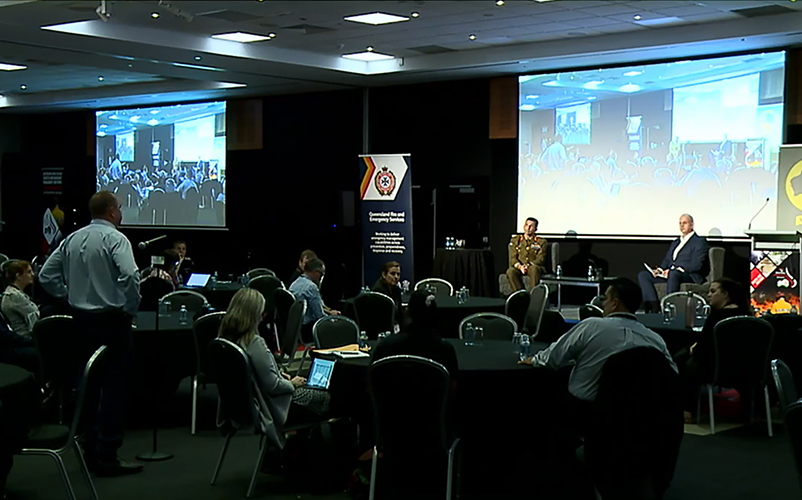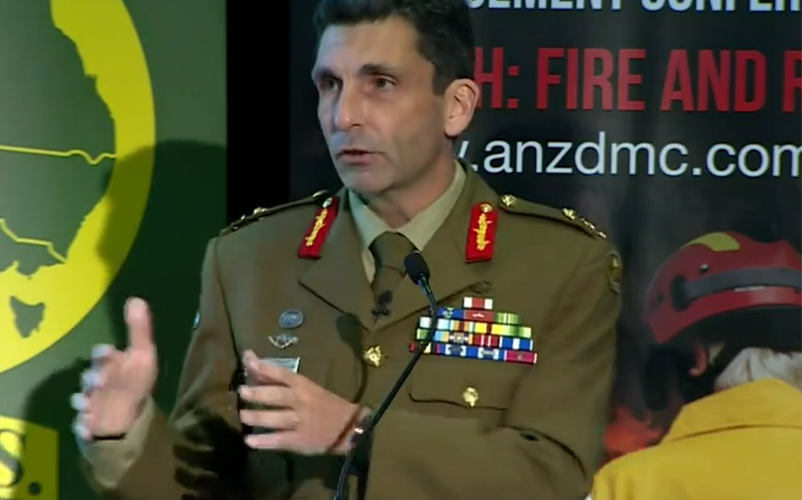Despite the overwhelming challenges presented to holding events during 2020, the Australian and New Zealand Disaster and Emergency Management Conference was held at the Gold Coast in October.
The conference was a hybrid event combining face-to-face and online elements that allowed over 600 attendees to participate across the 2-day event. It was a tremendous success and was the first of its kind for the Gold Coast Convention and Exhibition Centre. Research papers associated with presentations given at the conference are included in this edition of the Australian Journal of Emergency Management.
The co-hosts were the Bushfire and Natural Hazards Cooperative Research Centre, the Australian Institute of Emergency Services and the Australian and New Zealand Mental Health Association Inc.
Mr Sam Stewart, CEO of the Australian and New Zealand Mental Health Association said, ‘We were so pleased to deliver this conference after such a challenging year. It was wonderful to see the sector come together and keep updated with the sector’s progress'.
The official keynote session was delivered by Deputy Commissioner Steve Golleschewski from the Queensland Police Service. Mr Golleschewski examined the parallel use of adaptive leadership and command and control in considering the value of relationships. His presentation had a particular focus on the value of learnt and lived experience in being able to lead at strategic and operational levels.

The conference was a hybrid event combining face-to-face and online elements.
Image: Australian and New Zealand Disaster and Emergency Management Conference
Ms Abigail Trewin, Director of Disaster Preparedness and Response at the National Critical Care and Trauma Response Centre, gave a unique insight into managing and implementing complex and difficult crisis responses. She highlighted her learnings and explained how these can be relevant to disaster responders and shape their preparation for future events.
Shane Fitzsimmons, Commissioner of Resilience NSW, spoke of the disastrous 2019–20 bushfire season and the subsequent relief effort. He spoke about leadership, communication and preparedness and how it might evolve, noting that leadership is not a hierarchical structure but a shared responsibility.
Day 1 included 5 breakout sessions of 3 in-person sessions and 2 virtual sessions, all of which were recorded for access post-event. The program progressed well and provided a sense of achievement especially given the extra focus on COVID-19 health and safety requirements and the complexities of constant border closures. This was greatly assisted by the flexibility of presenters and conference staff. The day concluded with a presentation from Mr Rhys Jones, CEO of Fire and Emergency New Zealand and Ms Sascha Rundle, Former Manager at ABC Emergency Broadcasting. Mr Jones provided insight into the New Zealand model of operations that has 2 foci; to put out fires and also to build an emergency management organisation that works seamlessly with other emergency services and agencies to help communities prepare for, respond to and recover quickly from emergencies. This provided an interesting case study for the many Australians attending the conference.
Ms Rundle provided an overview of how media can work with emergency management organisations to allow communication to rural and regional communities.

Major General Jake Ellwood, Australian Defence Force, was part of the expert panel.
Image: Australian and New Zealand Disaster and Emergency Management Conference
Day 2 of the conference included a panel session moderated by Mr Chris Austin. The panel members were Commissioner Andrew Crisp, Emergency Management Victoria; Major General Jake Ellwood, Australian Defence Force; Dr Peter Mayfield, CSIRO; Dr Stephanie Rotarangi, Emergency Management Victoria and Commissioner Shane Fitzsimmons, NSW Resilience.
Each panellist shared their expertise to present learnings and describe some standout moments during 2019–20. They also discussed opportunities to prepare for and respond to future incidents, using multi-disciplinary strengths, science and technologies to strengthening the resilience of communities.
Delegates provided excellent feedback. Ms Jill Brix, General Manager of Avisure, commented, ‘Brilliant. I have been talking about the presentations, the COVID-safe plan and venue. Also, kudos to all the presenters for sharing their journeys and providing advice to others’.
The conference concluded with Mr Mike Wassing, Deputy Commissioner Emergency Management, Volunteerism and Community Resilience of the Queensland Fire and Emergency Services and Ms Nicole Sadler, Head of Policy and Practice at Phoenix Australia. Mr Wassing explained the place-based model used by Queensland Fire and Emergency Services and how it empowers local communities and enhances knowledge and practical skills to optimise their capability before, during and after emergency events. Ms Sadler used her closing address to remind attendees of the importance of mental health and the psychological demands of these occupations.


